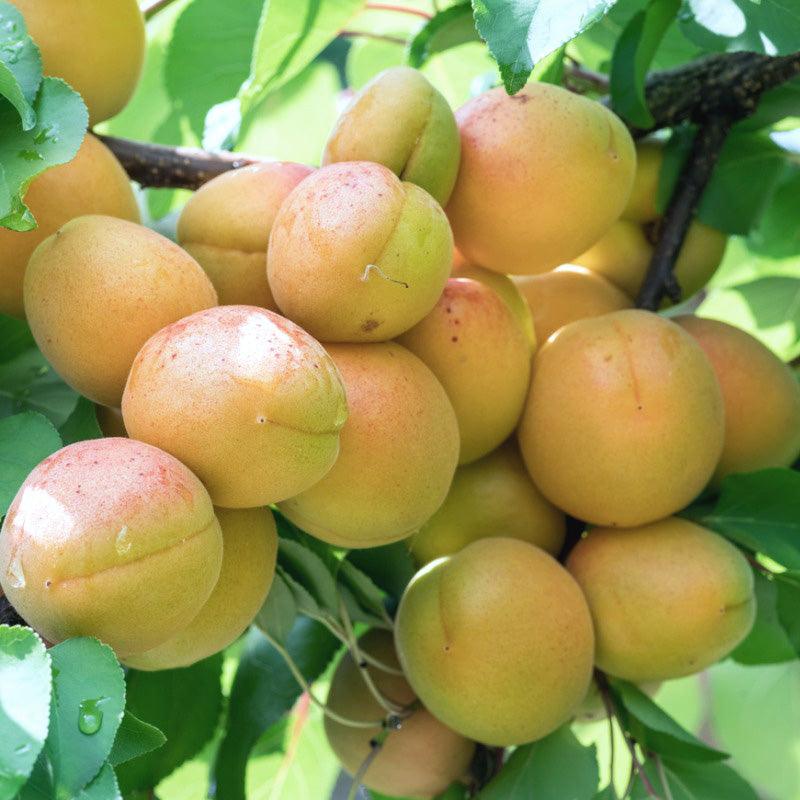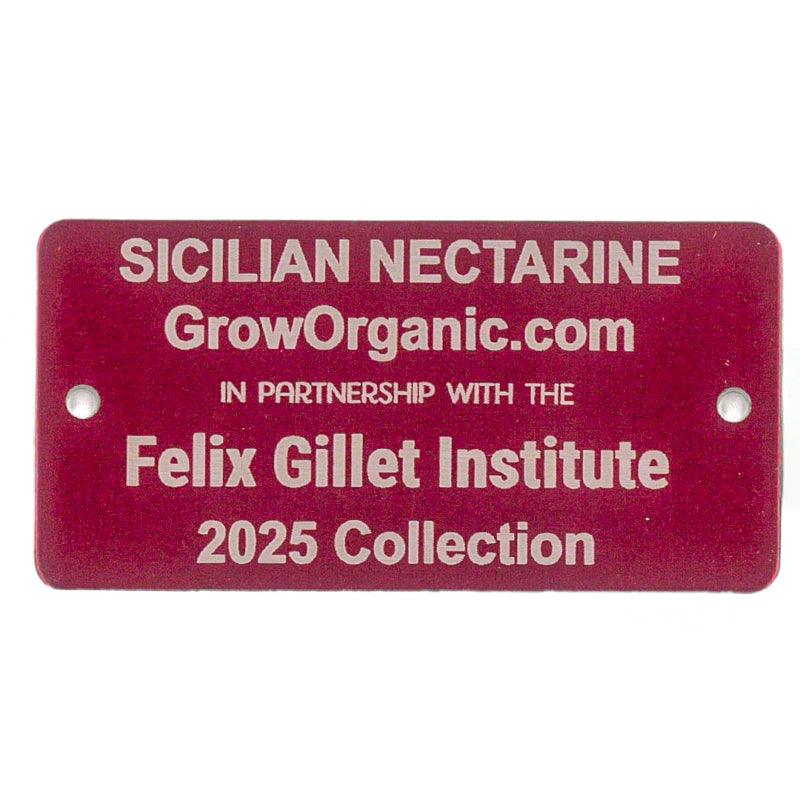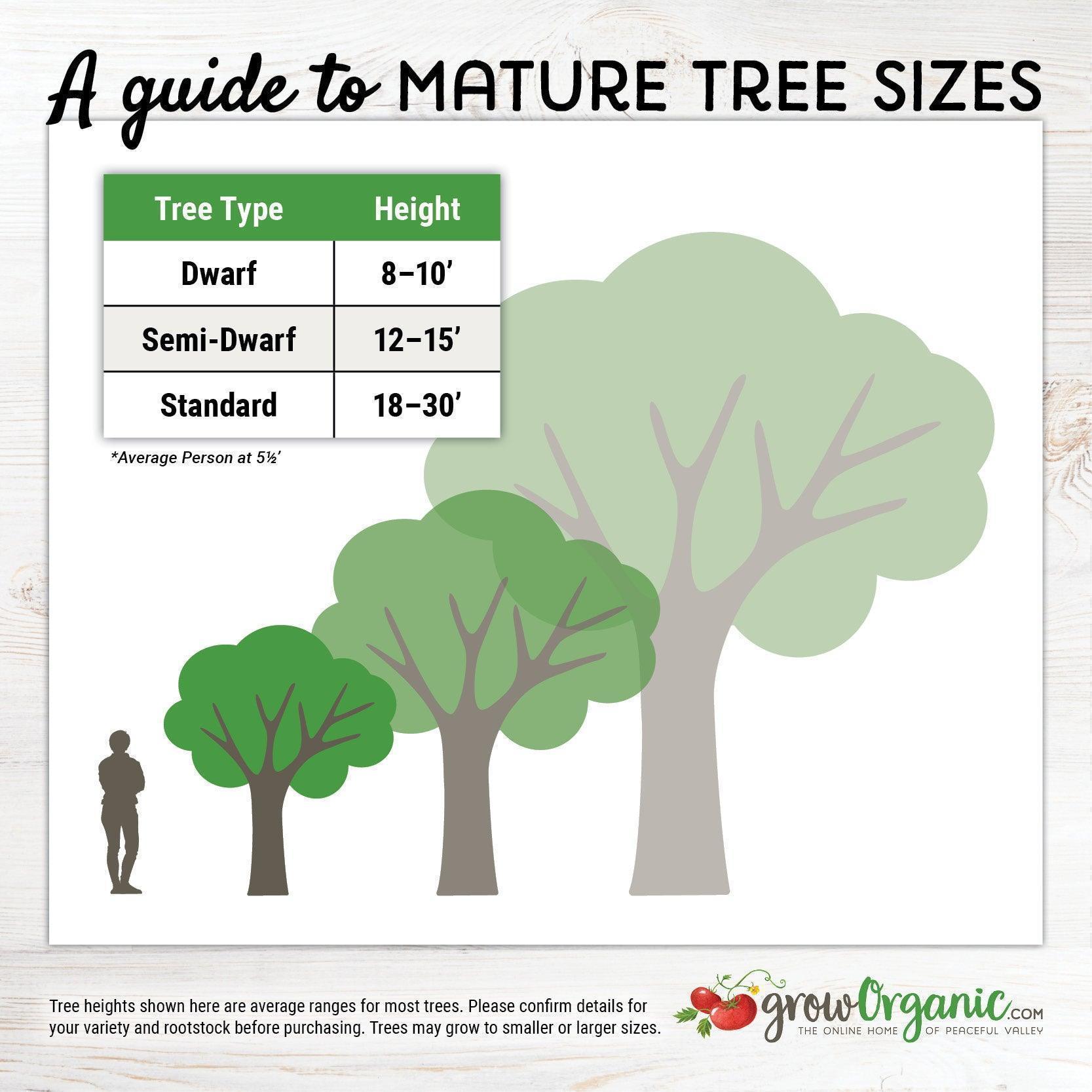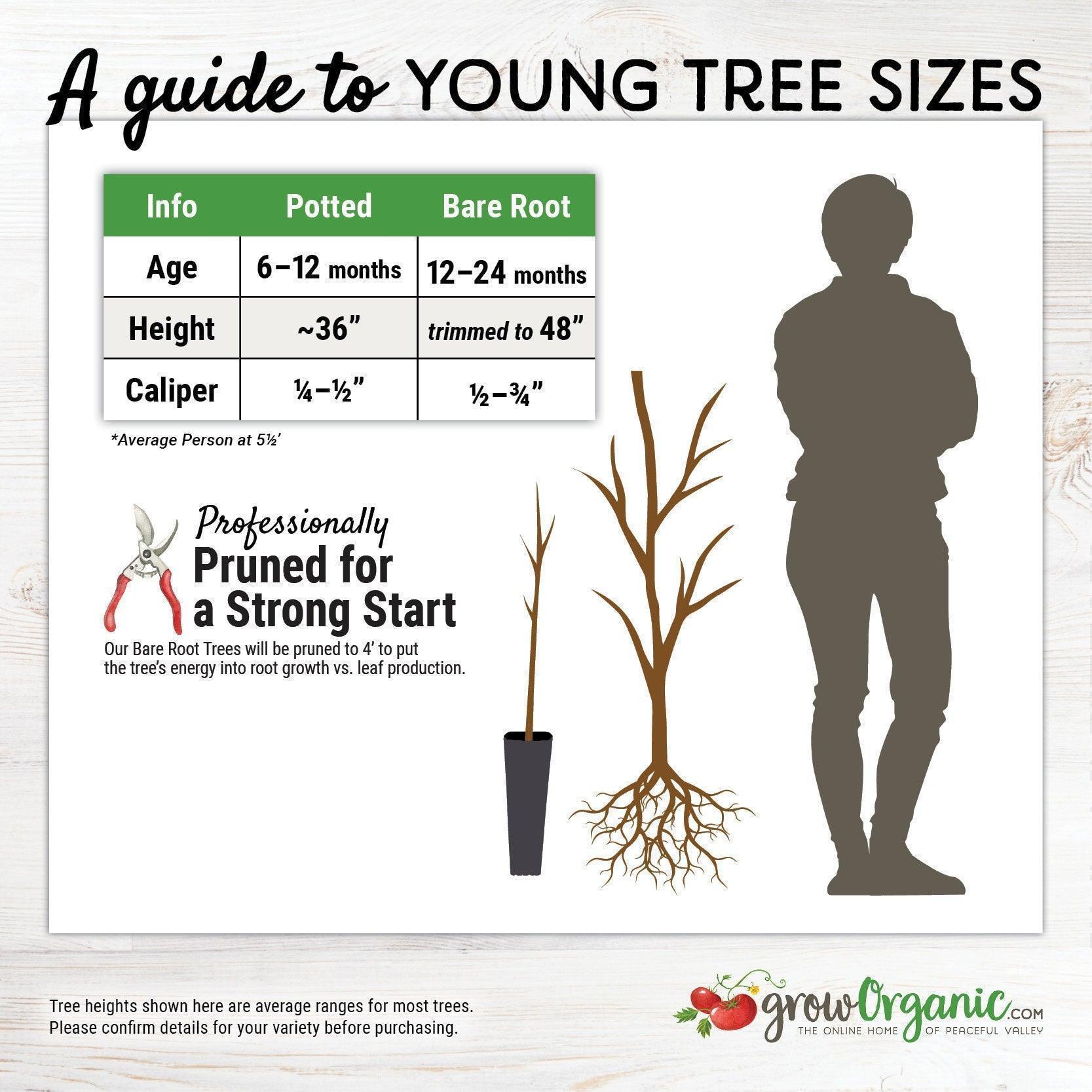Item Number: FT376
Sicilian Nectarine Tree
Sweet, Juicy White Flesh, Irresistible Taste.
Every rare tree purchase supports historical orchard preservation
Limited availability—reserve up to 5 rare trees per order while supplies last
Each handpicked tree includes a durable etched metal display tag.
Standard on Lovell Rootstock
The Sicilian Nectarine tree is a fascinating and delightful addition to any orchard, especially for those who appreciate historical varieties and the legacy of traditional horticulture. With white flesh, white skin and light red striping on the sunny side, this particular nectarine tree, believed to have been brought from Sicily to Grass Valley many decades ago, is a small but robust tree that yields fruit with a flavor unmatched by commercial varieties. Its historical significance, coupled with its unique and delicious fruit, makes it a must-have for connoisseurs and fruit enthusiasts alike.
Historical Background
The Sicilian Nectarine tree is a living testament to the rich agricultural traditions of Sicily and the enduring appeal of heirloom fruit varieties. Brought to Grass Valley as a seedling, this tree has thrived in its new environment, producing small, golden nectarines with a rich, sweet flavor. The tree’s history is deeply connected to the legacy of Felix Gillet, a pioneering horticulturist who introduced many fruit and nut trees to the American West during the 19th century. Gillet’s influence is evident in the propagation of this nectarine tree, which continues to bear fruit decades after it was first planted.
Grown on Lovell rootstock, the Sicilian Nectarine tree has adapted well to its surroundings, demonstrating a remarkable ability to produce fruit with minimal care and water. The grandmother tree, standing just 8 feet tall, is a healthy and productive specimen, yielding a moderate crop almost annually. This resilience and productivity make the Sicilian Nectarine tree a valuable heirloom variety, preserving the flavors and characteristics of a time-honored fruit that might otherwise be lost to history.
How to Grow a Sicilian Nectarine Tree
Growing a Sicilian Nectarine tree requires some knowledge of its specific needs and preferences. By following these guidelines, you can cultivate a healthy tree that produces the uniquely flavored nectarines for which it is known.
- Climate and Location: The Sicilian Nectarine tree thrives in a temperate climate with warm summers and mild winters. This tree is well-suited to regions similar to its original Mediterranean environment, where it can enjoy long, sunny days and relatively dry conditions. It is important to choose a planting site that receives full sun, as this will help the tree produce the best quality fruit. The tree’s historical connection to Grass Valley, a region with a Mediterranean-like climate, suggests that it may also do well in similar climates across the northern and southern hemispheres.
- Soil Requirements: The Sicilian Nectarine tree prefers well-drained soils with a slightly acidic to neutral pH. While it can tolerate a range of soil types, good drainage is essential to prevent root rot and other moisture-related issues. Lovell rootstock, on which this tree is grown, offers some resistance to wet conditions, making it slightly more adaptable to less-than-ideal soils. However, the tree still performs best in well-drained, loamy soils enriched with organic matter.
- Planting: When planting a Sicilian Nectarine tree, dig a hole that is twice as wide and just as deep as the root ball. Position the tree in the hole, ensuring that the graft union (where the rootstock meets the scion) is above the soil line. Backfill the hole with soil, gently firming it around the roots to eliminate air pockets. After planting, water the tree thoroughly to help it establish strong roots.
- Watering: Consistent watering is crucial, especially during the tree’s first few years of growth. The Sicilian Nectarine tree requires regular watering, particularly in dry conditions, to ensure healthy growth and fruit production. However, once established, the tree has shown a remarkable ability to produce fruit with minimal water, as evidenced by the grandmother tree in Grass Valley. This drought tolerance is one of the tree’s strengths, but it is still important to provide adequate moisture during critical periods such as flowering and fruiting.
- Pruning: Pruning is an essential part of caring for a Sicilian Nectarine tree. Prune the tree during its dormant season, typically in late winter, to remove dead or diseased branches and to shape the tree. Pruning encourages the growth of strong, healthy branches that can support the weight of the fruit. For best results, aim to create an open center or vase shape, which allows sunlight to penetrate the canopy and reach the developing fruit. This practice also improves air circulation, reducing the risk of fungal diseases.
- Fertilization: Fertilizing the Sicilian Nectarine tree helps support its growth and fruit production. Apply a balanced fertilizer in early spring, just as new growth begins, to provide the tree with essential nutrients. Additional feedings can be made throughout the growing season, particularly if the tree shows signs of nutrient deficiency. However, avoid over-fertilizing, as this can lead to excessive vegetative growth at the expense of fruit production.
Fruit Production
The Sicilian Nectarine tree is known for its moderate yet consistent fruit production. The young mother trees in the orchard are small but hardy, producing a reliable crop of nectarines each year. The fruit is small but packed with an incredibly rich, sweet, and delicate flavor, making it a prized addition to any fruit lover’s collection.
- Fruit Characteristics: The nectarines produced by this tree are small and golden, with white flesh and a unique light red striping on the sunny side. This distinctive appearance, combined with the fruit’s rich flavor, sets it apart from commercial varieties. The nectarines ripen slowly over a month rather than all at once, allowing you to enjoy them over an extended period. To determine when the fruit is ripe, gently squeeze it; a ripe nectarine will yield slightly to pressure.
Harvesting Nectarines
Harvesting nectarines from the Sicilian Nectarine tree requires careful attention to timing and handling to ensure that the fruit is at its peak flavor and quality.
- Harvest Timing: The nectarines from this tree ripen slowly over a month, rather than all at once. This extended ripening period allows you to harvest the fruit gradually, ensuring that each nectarine is picked at the perfect moment. To determine if a nectarine is ready for harvest, gently squeeze the fruit; it should feel slightly soft but not mushy. The fruit will also develop a sweet fragrance when it is fully ripe.
- Handling: The delicate nature of the Sicilian Nectarine’s skin means that the fruit must be handled with care to avoid bruising. When harvesting, place the nectarines gently into shallow containers, being careful not to stack them too high. This careful handling will help preserve the fruit’s quality and prevent spoilage.
- Post-Harvest Care: After harvesting, the nectarines can be enjoyed fresh or used in a variety of culinary applications. The unique flavor of this fruit makes it ideal for eating out of hand, as well as for use in desserts, preserves, and other dishes. If you have a surplus of nectarines, consider preserving them by canning, freezing, or drying. Proper storage is key to maintaining the quality of the fruit. Store ripe nectarines in a cool, dry place or refrigerate them to extend their shelf life.
Conclusion
The Sicilian Nectarine tree is a unique and historically significant variety that offers both exceptional flavor and a connection to a rich horticultural heritage. By following the guidelines for planting, care, and harvesting, you can enjoy the sweet rewards of this remarkable tree. Whether you are growing it for its connection to Felix Gillet and the historical legacy of heirloom fruit or simply for the delight of its delicious nectarines, the Sicilian Nectarine tree is sure to be a valuable and rewarding addition to your garden or orchard. Its small, golden fruit, with its rich, sweet flavor, is a testament to the enduring appeal of heirloom varieties and the joys of homegrown fruit.
For more information about different types of rootstocks and how they influence tree size and growth, see our Tree Rootstock Characteristics Chart.
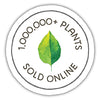


Check Your Zone Compatibility:
Compatible with your zone.
Growing Zone for

Our Guarantee To You
Since 1976, we've served our customers at every stage of growing. Please contact us at any time. We are happy to support and assist you.
Shipping Information
Shipping Information
Cannot ship to the following states: HI, AK, PR, GU, VI
Shipping Weight: 5.0 lb
Dimensions: 47.5"L x 7.3"W x 2.75"H
Features
Features
- Bare Root
- Clingstone
- Self-fruitful
- Suited to Cold Climates
Characteristics
Characteristics
Planting & Care
Planting & Care
Useful Information
Useful Information
Guarantee
Guarantee
Limited Dormant Tree & Plant Guarantee
* Claim deadline is June 15th
We guarantee that your dormant tree or plant will arrive in good, viable condition. If your tree arrives in substandard condition, notify us within 3 days of delivery. Please email pictures of the box, inside packaging, the tree and its roots to helpdesk@groworganic.com. We will investigate your claim and process a request to exchange or refund the damaged product.
If your dormant tree or plant has not grown new leaves by June 15th, you may be eligible for our Limited Dormant Tree & Plant Guarantee. This guarantee provides for a store credit for the purchase price of the tree, excluding shipping. Please see the Instructions below.
Important Dates:
- April 1st Dormant trees/plants must be planted in the ground
- May 15th Perform scratch test, if no new leaves have grown
- June 15th Deadline to apply for a dormant tree/plant credit
All required documentation must be received by June 15th for your claim to be considered. Claims or documentation received after June 15th will be denied, without exception. Instructions listed below
Terms and Conditions
We cannot guarantee that your tree or plant will remain alive and healthy after it is received, or bear fruit as there are too many variables in your environment that are beyond our control (i.e. soil preparation, weed and pest control, proper irrigation, chill hours, compatible hardiness for your growing zone, proper choice of pollinator, extreme weather, rodent damage, disease, etc.).
We cannot guarantee that we will be able to provide a replacement tree/plant of the same species either that same growing season or in future years. Customers are responsible for all shipping fees associated with replacement trees and plants.
If we determine that the tree you purchased directly from us is not viable, we will issue you a store credit (not a refund) for the purchase price of the affected dormant tree or plant. Shipping is not included in the dormant tree/plant guarantee. Store credits can be used to purchase any product we sell and are valid for use only until July 1st of the following year.
Historically, 98% of our dormant trees and plants grow and thrive when they have been cared for and planted using our growing guides. Dormant trees and plants must be planted in the ground by April 1st in order to be eligible for credit. If the ground in your area is still frozen solid, you may temporarily plant your tree or plant in a pot.
Potted, non-dormant trees or plants are excluded from this guarantee as they are not dormant at the time of shipment. Evergreen trees such as citrus, avocado and olive trees are not available for credit under the Dormant Tree and Plant Guarantee.
Instructions
We guarantee that your dormant fruit tree or plant will leaf out, if you care for it according to our growing guides. In the unlikely event that your dormant tree or plant does not have leaves by May 15th, follow these simple steps to apply for a store credit:
Before you call or email, please perform a “scratch test” to determine if the tree or plant is still alive. This video shows how to check for live tissue under the bark. Scratch tests need to be done a few inches above and below the graft.
Green Cambium Layer / Living Trees
If the cambium layer under the bark is green, give your tree a little more time. It is still alive, but hasn’t come out of dormancy yet. Check to make sure that it is getting the right amount of deep root water, enough sunlight and that the weather is warm enough for that type of tree/plant to come out of dormancy. Every tree has its own personality and will come out of dormancy at different times. Be sure to submit the required documentation listed below by June 15th, if it doesn’t grow leaves.
Brown Cambium Layer / Dead Trees
If the scratch test shows a brown cambium layer or if your dormant tree/plant doesn’t have leaves by June 1st, please email us at helpdesk@groworganic.com. All required documentation listed below must be received by June 15th for your claim to be considered. To be considered for the guarantee claim, all required documentation must be received by June 15th. Incomplete submissions will be denied.
Required Documentation
- Order number
- Name of dormant tree/plant and the quantity affected
- Photos of each tree or plant showing:
- The roots (tree or plant must be pulled out of the ground)
- The scratch test areas
- The entire tree/plant
We reserve the right to not issue credit for items that have already been replaced. We also reserve the right to require photographic evidence that the tree/plant was not killed by root rot, rodent or mechanical damage.
Share
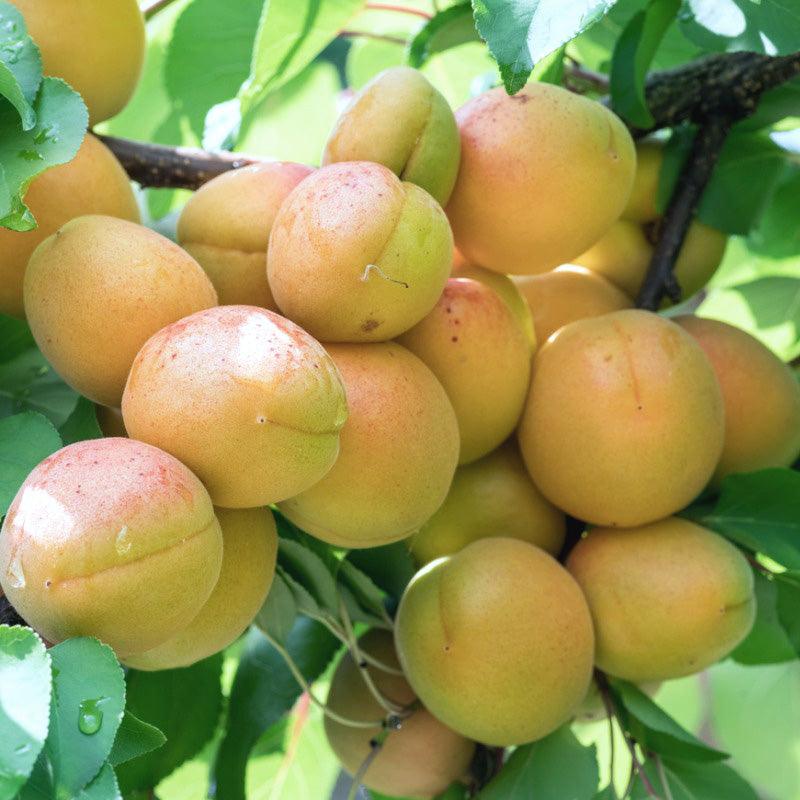


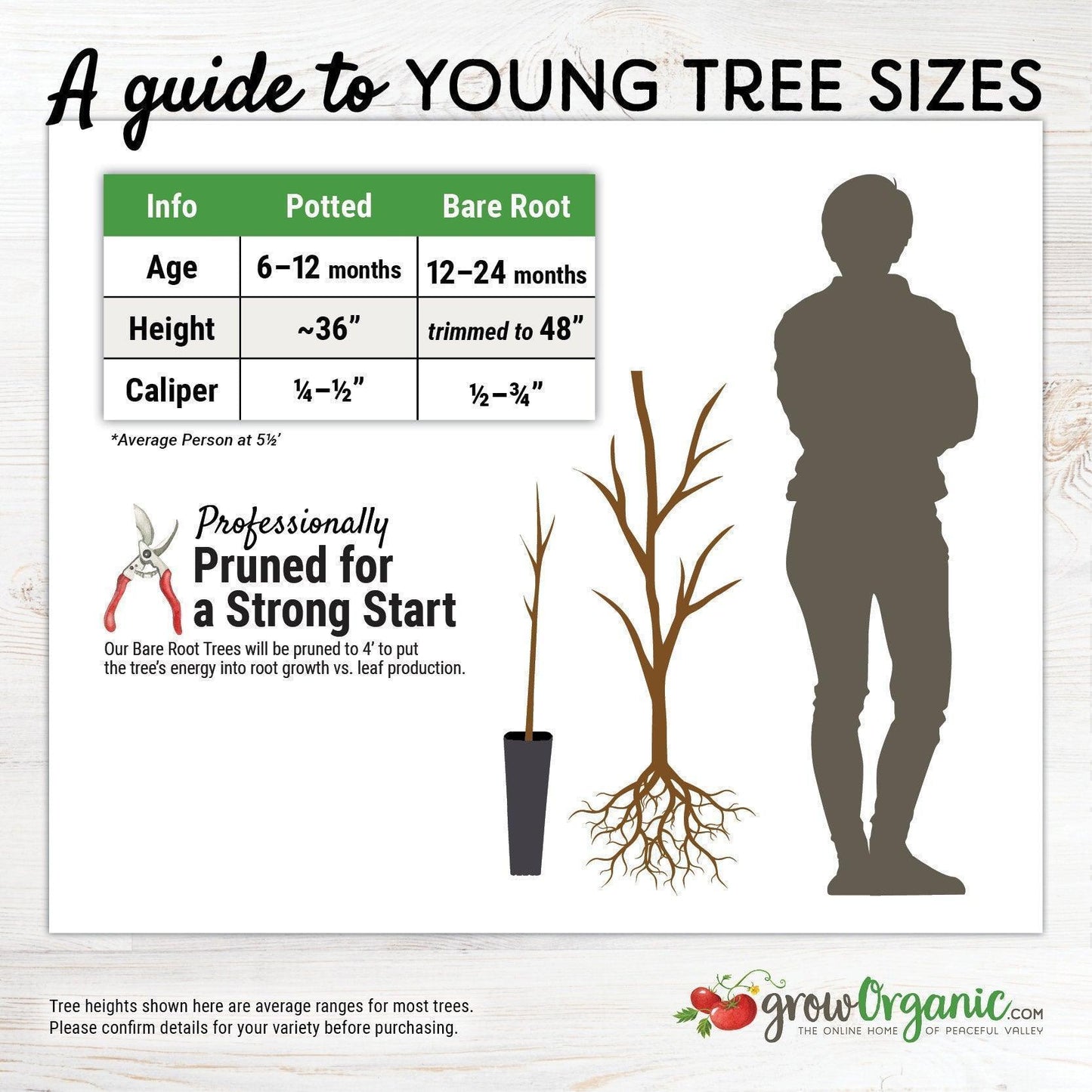
Of course I can’t deposit on fruit or anything, but I can certainly say good things about the vigor and health of the tree. It arrived in great shape. Everything as hoped. I confess I recently even moved the already planted tree, and it showed no stress. That is some health! I’d buy it again if ai ever needed one.
We just received this bareroot tree and planted it. Already leaves are beginning to sprout. Cannot wait until it gives us fruit. I have never tasted this variety but I am in love with so many of the heirloom varieties of fruit trees.
The tree came in perfect condition and so easy to care for until it’s ready to be planted.
Thank you!

